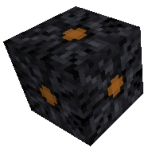Difference between revisions of "Cable"
Viktor Berg (talk | contribs) |
Viktor Berg (talk | contribs) |
||
| Line 9: | Line 9: | ||
}} | }} | ||
The ''Cables'' are the primary means of transferring [[EU]] from one device to another. There are several different | The '''Cables''' are the primary means of transferring [[EU]] from one device to another. There are several different tiers of cables, depending on how much current they can tolerate. If too much current is applied to a cable, it will instantly melt. Different tiers are made out of different metals. Furthermore, all cables suffer from distance-related energy losses - long cables will inevitably lose energy in the process of transferring it. There are several ways to offset it - Transformers and insulation. For higher-tier cables, the insulation also reduces the amount of shock damage the player and NPC's receive from touching the cable under high voltage. | ||
Cables can also be painted using the [[Painter]]. This separates them, preventing cables of different colors from interacting with each other. This also greatly reduces the strain on CPU, as large cable meshes with many intersections require the game to peform many CPU-heavy calculations. | Cables can also be painted using the [[Painter]]. This separates them, preventing cables of different colors from interacting with each other. This also greatly reduces the strain on CPU, as large cable meshes with many intersections require the game to peform many CPU-heavy calculations. | ||
= Cable | == Cable types == | ||
== Copper Cable | === Copper Cable === | ||
{| | {| | ||
| Line 35: | Line 33: | ||
|Output=Copper_Cable}} | |Output=Copper_Cable}} | ||
Copper cables are the cheapest, and the most basic cable tier. They are only capable of handling '''Low Voltage''' (up to 32 [[EU|EU/s]]), however, they suffer the smallest distance-related energy losses out of all the conventional cables, with insulated copper cables having even less energy losses. | |||
Copper cables are the cheapest, and the most basic cable | |||
=== Other cable types === | |||
There are 3 additional cable tiers: | |||
* Tier 2: [[Gold Cable]]: can handle up to 128 EU/s, higher energy loss than Copper Cables. | |||
* Tier 3: [[HV Cable]]: can handle up to 2048 EU/s, very high energy loss. | |||
* Tier extra: [[Glass Fibre Cable]]: can handle up to 512 EU/s, very low energy loss. | |||
== Cable Efficiency == | == Cable Efficiency == | ||
All cables suffer distance-related energy losses, and depending on the | All cables suffer distance-related energy losses, and depending on the tier and insulation of the given cable, the losses can vary greatly. The general unit for cable efficiency is EU/block. It shows how much EU the given cable loses per block. The number is accumulated along the whole length of the cable, and then rounded down to the nearest integer. | ||
{| class="wikitable" | {| class="wikitable" | ||
Revision as of 23:19, 1 September 2011
| Cable | |
|---|---|
| Properties | |
| Type | Wiring
|
| Stackable | Yes (64)
|
| Technical Details | |
| UU Cost | {{{uu_cost}}} |
| First appearance | ? |
| ID | IC2:{{{id}}} |
|
| |
The Cables are the primary means of transferring EU from one device to another. There are several different tiers of cables, depending on how much current they can tolerate. If too much current is applied to a cable, it will instantly melt. Different tiers are made out of different metals. Furthermore, all cables suffer from distance-related energy losses - long cables will inevitably lose energy in the process of transferring it. There are several ways to offset it - Transformers and insulation. For higher-tier cables, the insulation also reduces the amount of shock damage the player and NPC's receive from touching the cable under high voltage.
Cables can also be painted using the Painter. This separates them, preventing cables of different colors from interacting with each other. This also greatly reduces the strain on CPU, as large cable meshes with many intersections require the game to peform many CPU-heavy calculations.
Cable types[edit]
Copper Cable[edit]
Copper cables are the cheapest, and the most basic cable tier. They are only capable of handling Low Voltage (up to 32 EU/s), however, they suffer the smallest distance-related energy losses out of all the conventional cables, with insulated copper cables having even less energy losses.
Other cable types[edit]
There are 3 additional cable tiers:
- Tier 2: Gold Cable: can handle up to 128 EU/s, higher energy loss than Copper Cables.
- Tier 3: HV Cable: can handle up to 2048 EU/s, very high energy loss.
- Tier extra: Glass Fibre Cable: can handle up to 512 EU/s, very low energy loss.
Cable Efficiency[edit]
All cables suffer distance-related energy losses, and depending on the tier and insulation of the given cable, the losses can vary greatly. The general unit for cable efficiency is EU/block. It shows how much EU the given cable loses per block. The number is accumulated along the whole length of the cable, and then rounded down to the nearest integer.
| Cable type | EU/b | Energy loss |
|---|---|---|
| Copper Uninsulated | 0.3 | 1 EU every 3.33 blocks |
| Copper Insulated | 0.2 | 1 EU every 5 blocks |
| Gold Uninsulated | 0.5 | 1 EU every 2 blocks |
| Gold Insulated | 0.45 | 1 EU every 2.22 blocks |
| Gold 2x Insulated | 0.4 | 1 EU every 2.5 blocks |
| HV Uninsulated | 1 | 1 EU every block |
| HV Insulated | 0.95 | 1 EU every 1.05 blocks |
| HV 2x Insulated | 0.9 | 1 EU every 1.11 blocks |
| HV 4x Insulated | 0.8 | 1 EU every 1.25 blocks |
| Glas Fibre | 0.05 | 1 EU every 20 blocks |
| |||||||||||||||||||||||||||||||||||||||||||||||||||||||||||||||||||||||||||||||||||||||||||||||||||||||||||||||||||||||||||||||||||||||||||||||||||||||||||||||||||||||||||||||||||||||||||||||||||||||||||||||||||||||||||||||||||||||||||||||||||||||||||||

